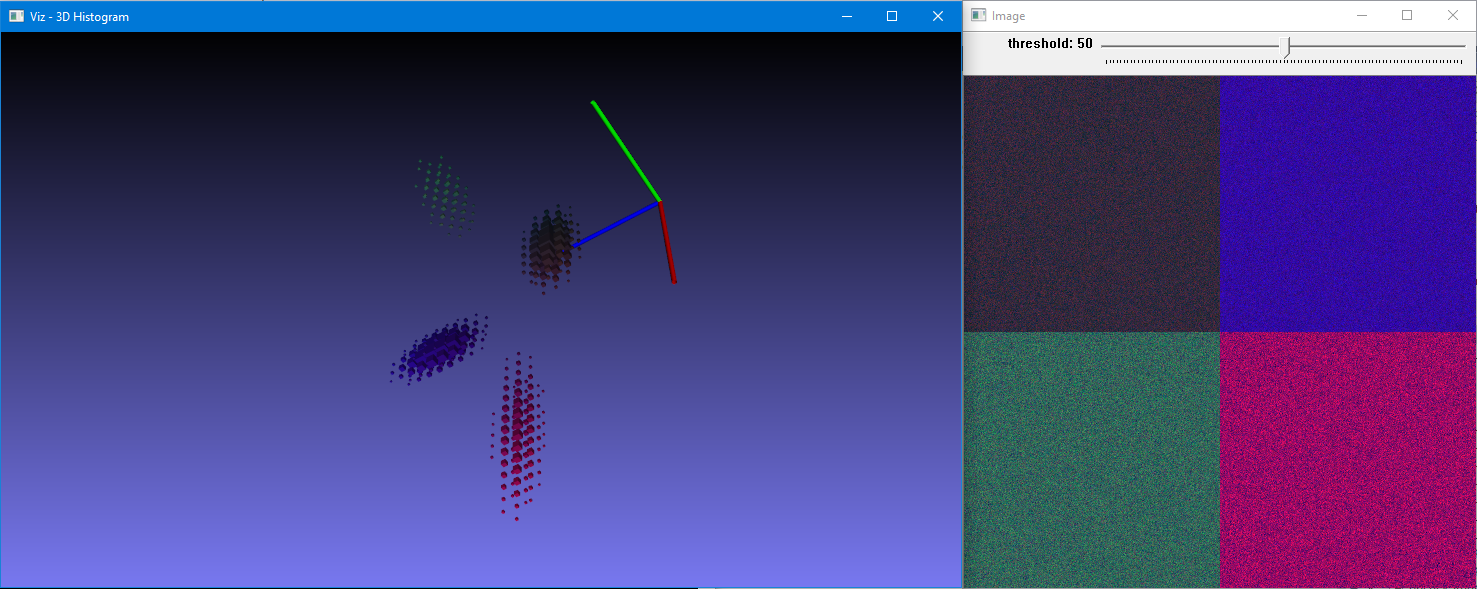Prev Tutorial: Creating Widgets
Goal
In this tutorial you will learn how to
- Create your own callback keyboard function for viz window.
- Show your 3D histogram in a viz window.
Code
You can download the code from here.
Explanation
Here is the general structure of the program:
You can give full path to an image in command line
CommandLineParser parser(argc, argv, keys);if (parser.has("help")){parser.printMessage();return 0;}Mat img;if (nomFic.length() != 0){img = imread(nomFic, IMREAD_COLOR);if (img.empty()){cout << "Image does not exist!";return 0;}}or without path, a synthetic image is generated with pixel values are a gaussian distribution cv::RNG::fill center(60+/-10,40+/-5,50+/-20) in first quadrant, (160+/-20,10+/-5,50+/-10) in second quadrant, (90+/-10,100+/-20,50+/-20) in third quadrant, (100+/-10,10+/-5,150+/-40) in last quadrant.
Image tridimensional histogram is calculated using opencv cv::calcHist and cv::normalize between 0 and 100.
Histo3DData h;h.status=true;h.seuil=90;h.threshold= h.seuil/1000000.0;float hRange[] = { 0, 256 };const float* etendu[] = { hRange, hRange,hRange };int hBins = 32;int histSize[] = { hBins, hBins , hBins };int channel[] = { 2, 1,0 };minMaxIdx(h.histogram,NULL,&h.maxH,NULL,NULL);channel are 2, 1 and 0 to synchronise color with Viz axis color in objetc cv::viz::WCoordinateSystem.
A slidebar is inserted in image window. Init slidebar value is 90, it means that only histogram cell greater than 9/100000.0 (23 pixels for an 512X512 pixels) will be display.
namedWindow("Image");imshow("Image",img);AddSlidebar("threshold","Image",0,100,h.seuil,&h.seuil, UpdateThreshold,&h);waitKey(30);We are ready to open a viz window with a callback function to capture keyboard event in viz window. Using cv::viz::Viz3d::spinOnce enable keyboard event to be capture in cv::imshow window too.
h.fen3D = makePtr<viz::Viz3d>("3D Histogram");h.nbWidget=0;h.fen3D->registerKeyboardCallback(KeyboardViz3d,&h);DrawHistogram3D(h);while (h.code!=27){h.fen3D->spinOnce(1);if (h.status)DrawHistogram3D(h);if (h.code!=27)h.code= waitKey(30);}The function DrawHistogram3D processes histogram Mat to display it in a Viz window. Number of plan, row and column in three dimensional Mat can be found using this code :
int planSize = (int)h.histogram.step1(0);int cols = (int)h.histogram.step1(1);int rows = (int)planSize / cols;int plans = (int)h.histogram.total() / planSize;h.fen3D->removeAllWidgets();h.nbWidget=0;if (h.nbWidget==0)h.fen3D->showWidget("Axis", viz::WCoordinateSystem(10));To get histogram value at a specific location we use cv::Mat::at(int i0,int i1, int i2) method with three arguments k, i and j where k is plane number, i row number and j column number.
for (int k = 0; k < plans; k++){for (int i = 0; i < rows; i++){for (int j = 0; j < cols; j++){double x = h.histogram.at<float>(k, i, j);if (x >= h.threshold){double r=std::max(x/h.maxH,0.1);viz::WCube s(Point3d(k - r / 2, i - r / 2, j - r / 2), Point3d(k + r / 2, i + r / 2, j + r / 2), false, viz::Color(j / double(plans) * 255, i / double(rows) * 255, k / double(cols) * 255));h.fen3D->showWidget(format("I3d%d", h.nbWidget++), s);}}}}- Callback function Principle are as mouse callback function. Key code pressed is in field code of class cv::viz::KeyboardEvent.
Results
Here is the result of the program with no argument and threshold equal to 50.

 1.9.6
1.9.6